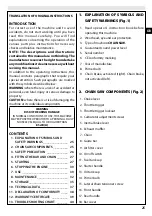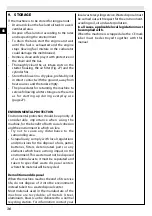
31
I
GB
F
D
E
NL
P
GR
TR
CZ
SK
RUS
UK
PL
H
LV
EST
LT
RO
PROHIBITED USE
WARNING - Always follow the safety
regulations. This chain saw is designed
and built for pruning and tending standing
trees or shrubs. It is forbidden to cut other
types of material. Vibrations and kickback
vary with different materials and the
requirements of the safety regulations would
not be respected. Do not use the chainsaw as
a lever for lifting, moving or splitting objects.
Do not lock it over fixed stands. It is forbidden
to hitch tools or applications to the P.t.o. that
are not specified by the manufacturer.
PRECAUTIONS FOR THE WORK AREA
- Do not work near electrical cables.
- Work only in conditions offering sufficient
visibility and light to see clearly.
- Stop the engine before setting the chainsaw
down.
- Be particularly cautious and alert when
wearing ear protectors, as these can restrict
your ability to hear sounds indicating danger
(shouts, signals, warnings, etc.)
- Be extremely careful when working on slopes
or uneven surfaces.
- Do not cut above chest height, as a saw held
higher is difficult to control against kickback
forces.
- Do not cut from a ladder, this is extremely
dangerous.
- Stop the saw if the chain strikes a foreign
object. Inspect the saw and repair parts as
necessary.
- Keep the chain out of dirt and sand. Even a
small amount of dirt will quickly dull a chain
and increase the possibility of kickback.
- Always keep the handles dry and clean.
- When cutting a limb that is under tension, be
alert for springback so you will not be struck
when the tension in the wood fibre is released.
- Take great care when cutting small branches or
shrubs which can block the chain, be thrown
back towards you or cause you to lose your
balance.
OPERATING INSTRUCTIONS
WARNING - Tree filling is a task that
requires experience. Not groped tree
filling if you are inexperienced. AVOID
ALL TRANSACTIONS FOR WHICH YOU ARE
NOT QUALIFIED! It is recommended that
inexperienced operators to refrain tree filling
if the trunk has a diameter greater than the
length of the bar. When using the chainsaw
for the first time, make several cuts in a small
trunk in order to become familiar with the
saw in action. Always use full throttle when
cutting with the saw, regardless of the size of
the timber. Never push down on the saw when
cutting. The weight of the saw alone enables it
to cut properly with minimum effort.
WARNING - Never cut in high wind, bad
weather, when visibility is poor or in very
high or low temperatures. Always check the
tree for dead branches which could fall during
the felling operation.
TREE FELLING
In tree filling and bucking operations exploit the
presence of spike bumpers, pivoting on it. Study
the tree and surrounding area before starting to
cut. Clear the work area before beginning to cut.
Prepare the widest possible path of retreat for
when the tree falls (Fig. 17). Cut off any branches
at the bottom of the trunk up to a height of
about 2 metres. Make a 90 degree notch on
the face of the tree, in the direction it will fall.
The depth of the notch should never exceed
1/4 of the diameter of the trunk (1 - Fig. 18).
About 10 cm (4”) higher up the trunk make a cut
down towards the first cut, in order to extract a
wedge. This is the mouth of the hinge, and is the
direction in which the tree falls (2 - Fig. 18).
Now, make your felling cut on the opposite
side of the trunk. Start the cut about 4-5 cm (2”)
higher than the center of the notch (3 - Fig. 18).
Always leave a hinge (A, Fig. 19-24) which allows
you to control the direction the tree falls in. Put a
wedge into the felling cut, before the tree starts
to move, to prevent the chainsaw guide bar from
getting stuck.
If the diameter of the trunk is greater than the
length of the guide bar, make the felling cut as
shown in the sequence of Fig. 19.
LIMBING
a) Always start from the larger diameter and
move towards the tip to cut off limbs and any
Summary of Contents for GSH 510
Page 2: ...2 18 2 14 15 3 9 7 5 6 8 16 1 17 10 11 13 12 4 1 2 ...
Page 3: ...3 L L M H E L C F N G D B A 3 5 7 9 4 6 8 10 ...
Page 4: ...4 B C I O STOP OPEN D A CLOSE B C I O STOP OPEN D A CLOSE 11 13 15 17 12 14 16 ...
Page 5: ...5 18 19 20 21 23 22 24 ...
Page 6: ...6 A B T 0 5 mm L8RTF 26 28 30 25 27 29 31 32 C A B ...
Page 8: ......
Page 185: ......
















































